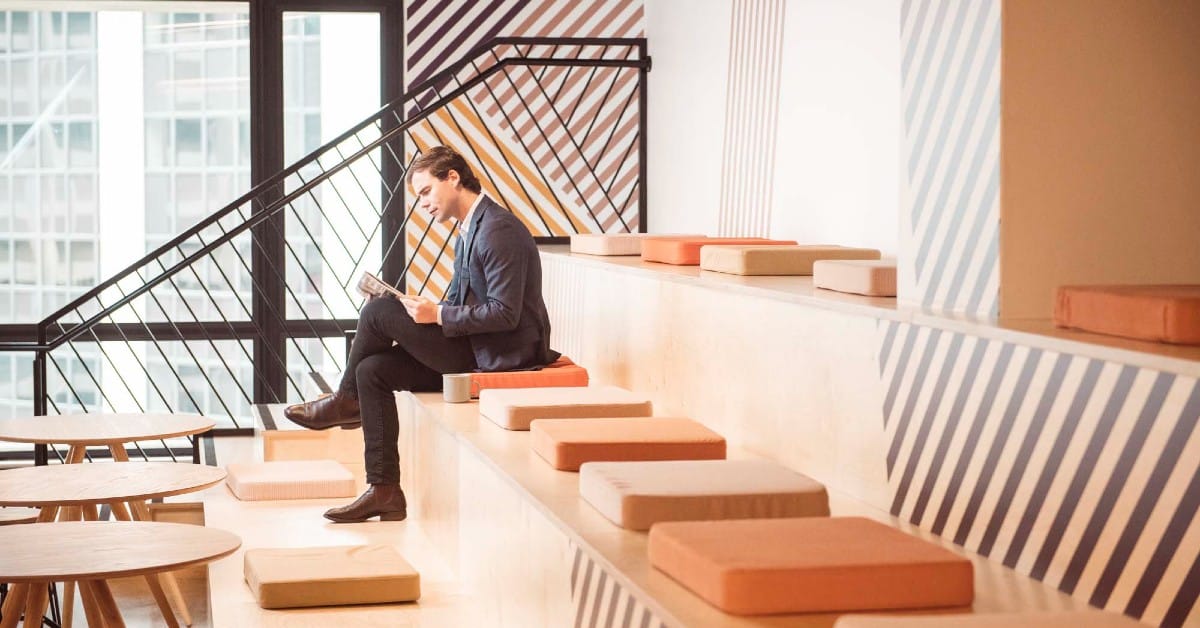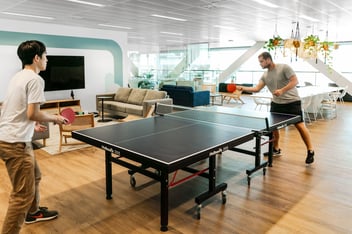
The workplace design trends shaping 2022

It's safe to say that we've become accustomed to a new way of working. While the much-talked-about 'new normal' is a bit of a moving target, we've learned to adapt, and now our workplaces are too.
Hybrid working is quickly becoming the norm for many. Workers are leaving behind the hustle mentality. Employees are prioritising their wellbeing and are willing to leave organisations that don't. So, how does workplace design fit in?
These are the four workplace design trends you need to know about:
1. Hybrid working and flexible spaces
With hybrid and flexible working becoming the norm for many ex full-time office workers, workplaces in 2022 need to adapt.
If the past two years have taught us anything, it's that uncertainty and change are the only things we can rely upon. So building workplaces that can accommodate both of these things is crucial to workplace effectiveness.
Your space now needs to flex with capacity requirements and safe physical distancing protocols, as well as encourage your current employees to come to the office and attract new talent.
With many people opting to work part of the week from home, your organisation has been given the flexibility to do away with assigned seating and instead create all kinds of bookable and non-bookable spaces: collaboration hubs, task-oriented work zones, social areas etc.
We also predict an uptick in modular furniture and multipurpose spaces, accommodating changes in office capacity and changing workplace requirements.
For example, Axiom recently created a multipurpose collaborative zone within a breakout space that doubles as town hall and presentation space for Partners in Performance, an international management consultancy firm.
Giving your employees workplace options gives them autonomy to decide where to work from depending on their task, increasing their productivity and boosting employee engagement.
In 2022, we also anticipate augmented base-building features like fitness amenities, dining and food options, conference and gathering spaces and outdoor areas to become more common.
2. AI and data
Working from home during the pandemic has concreted our dependence on smart technology. From cueing Alexa to play a focus playlist to relying on Otter.ai to take meeting notes on a Zoom conference, how we work has evolved. And now the workplace has to too.
Smart workplaces use digital sensors to monitor and respond to light levels, air quality, and occupancy. The data collected helps organisations understand how, when, and why spaces are being used and optimise the working environment.
With all this workplace data, AI is helping us put it to use in the workplace by identifying patterns and trends, producing reports, and uncovering and predicting behaviours. All to make the workplace a more efficient, productive and enjoyable place.
Providing a frictionless experience for employees is the strategy, and any workplace feature that delivers is in high demand.
3. People-centred design and a focus on wellbeing
The destination workplace isn't new, but its importance is only growing in 2022. After two tumultuous years, people need a reason and purpose to come into the office beyond a policy or mandate. Not only does the space need to make employees feel safe, but it also needs to prioritise wellbeing, social connectedness and, of course, collaboration. In short, it needs to put the people at the centre.
The obvious place to start is with your people. What do they want from their workplace? It could be a meditation room, it could be onsite childcare, it could be a space with ample room for their whole team to gather once a week, or it could be membership to the gym downstairs. The key is to make coming to the office an employee-driven choice, not one driven by the business.
Make the office a useful, valuable and beneficial place for employees to come - not just professionally but personally.
We saw this in action with IT company Cisco Meraki. As a part of their workplace design, we included a fully functioning commercial kitchen to allow for cooking meals for all staff and functions. Another example was for HR tech company ELMO, where we incorporated a yoga/meditation room that facilitates daily sessions for a variety of wellbeing workshops and an escape from the work environment.
4. Sustainability
Australians have never been more aware of their environmental impact than they are right now. But it's not just individual effects people are taking note of; it's also at an organisational level. People care about working for and with businesses that care about their environmental impact.
Unsurprisingly then, sustainable workplace design continues to be a priority for 2022. Passive ventilation, using low-emission materials, recycling materials, furniture and decor, exploiting natural light and using energy-saving fittings like LED lights are all practices that can leave a softer environmental footprint. We also anticipate more workplaces utilising smart tech to control energy waste (e.g. digital sensors linked to air conditioning or lighting), lightening the load even further.
It doesn't end there. Clever workplace strategists are designing offices to encourage more green behaviours like installing bicycle storage, lockers and showers or installing a range of bins that include recycling and organic options. Match this with a cultural push towards a more eco-conscious workforce, and your organisation can make a real and lasting impact.
What else is on the horizon for the workplace of the future? Find out in our ultimate future of work guide.




